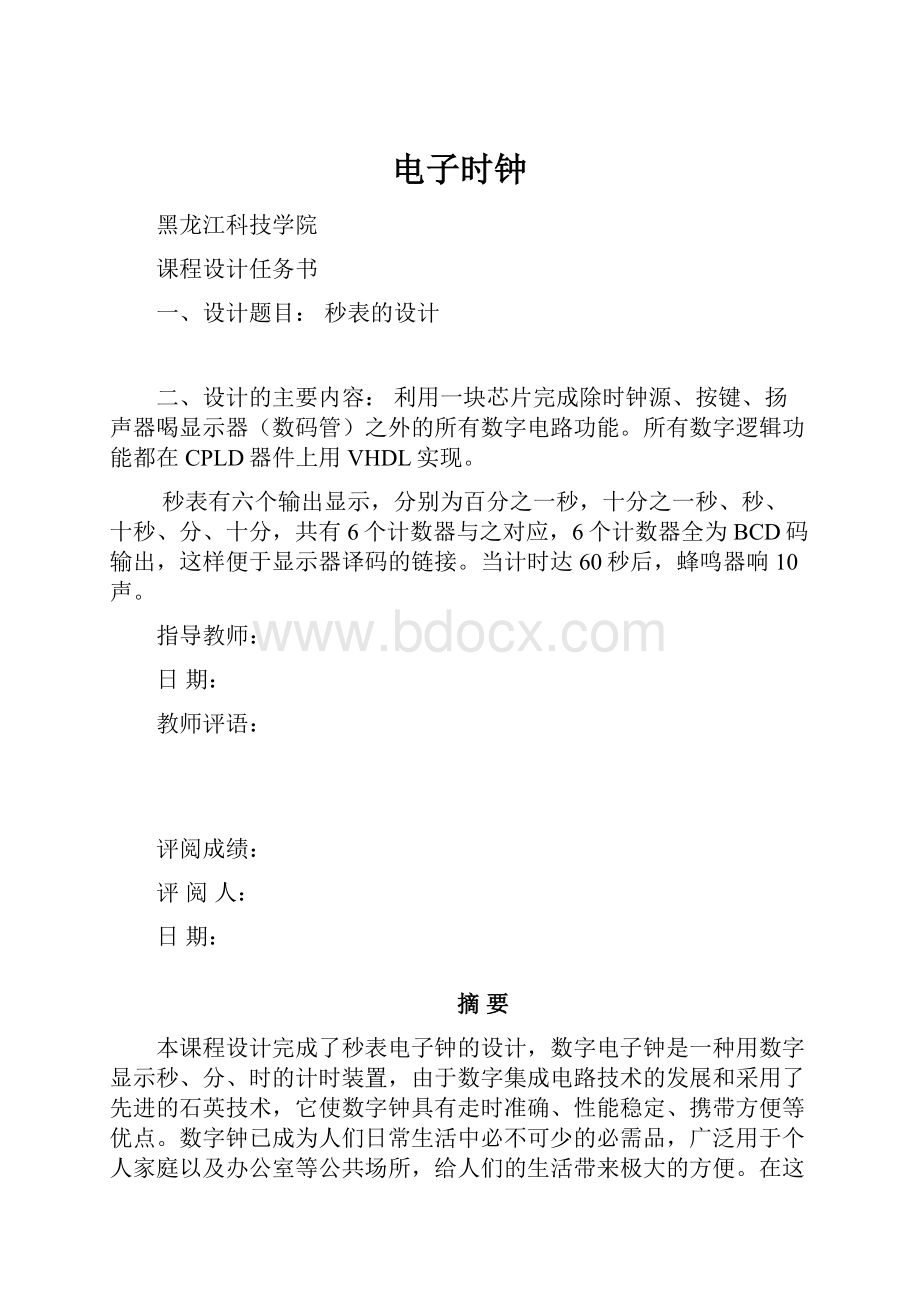电子时钟.docx
《电子时钟.docx》由会员分享,可在线阅读,更多相关《电子时钟.docx(26页珍藏版)》请在冰豆网上搜索。

电子时钟
黑龙江科技学院
课程设计任务书
一、设计题目:
秒表的设计
二、设计的主要内容:
利用一块芯片完成除时钟源、按键、扬声器喝显示器(数码管)之外的所有数字电路功能。
所有数字逻辑功能都在CPLD器件上用VHDL实现。
秒表有六个输出显示,分别为百分之一秒,十分之一秒、秒、十秒、分、十分,共有6个计数器与之对应,6个计数器全为BCD码输出,这样便于显示器译码的链接。
当计时达60秒后,蜂鸣器响10声。
指导教师:
日期:
教师评语:
评阅成绩:
评阅人:
日期:
摘要
本课程设计完成了秒表电子钟的设计,数字电子钟是一种用数字显示秒、分、时的计时装置,由于数字集成电路技术的发展和采用了先进的石英技术,它使数字钟具有走时准确、性能稳定、携带方便等优点。
数字钟已成为人们日常生活中必不可少的必需品,广泛用于个人家庭以及办公室等公共场所,给人们的生活带来极大的方便。
在这里我们将已学过的比较零散的数字电路的知识有机的、系统的联系起来用于实际,来培养我们的综合分析和设计电路的能力。
关键词:
秒表、计时装置、石英技术
第1章电子时钟概述
1.1设计目的
随着时代的发展,社会的进步,现在人们的生活节奏是越来越快,所谓争分夺秒,时间就是金钱之说历史已久,电子时钟也由来变成人们生活必不可少的。
电子时钟有着看时间方便,能够定制提醒,有着任务和日常记事功能。
设计这样的电子时钟,方便了我们的出行,我们的约会,我们的工作等。
通过本次实验掌握多位计数器相连的设计方法。
掌握十进制,六进制,二十四进制计数器的设计方法。
继续巩固多位共阴极扫描显示数码管的驱动及编码。
掌握扬声器的驱动和LED灯的花样显示。
1.2设计要求
为了简化程序设计及增加可读性,本系统仍采取模块化的设计方式,重复使用的功能模块均以组件(component)的形式存在,以便相关块的调用。
主程序内的不同功能的模块构成一个完整的结构。
为了便于时钟计数,需要1hz的时钟信号。
为了节省电路耗电,输出显示采用了四合一七段显示器来显示分与秒共4个数字,另外2个数字的小时显示也采用四合一七段显示器来显示。
由于需要一个除以1024hz的分频器,用来实现系统输入信号产生一个1hz的时钟信号。
能进行正常的时、分、秒计时功能,分别由6个数码管显示24h、60min、60s。
按下rst键时,起到复位功能总清0。
按下choose_mode键时,能够在12进制和24进制之间转换显示。
按下set_hou、set_min可以设置小时和分钟。
可以设置闹铃报时。
第2章电子时钟设计思想
2.1模块设计思想
2.1.1count6模块
该模块实现模6输出功能。
当计数满6时,计数器清零并产生一个进位标示。
即当carry2满6时,value2变为1。
2.1.2country10模块
该模块同count6模块相同,当计数器满10时,计数器清零并产生一个进位标示。
即当carry1满10时,value1变为1。
2.1.3count12模块
12进制计数作为一个整体,和cout6和count10相同计数器满12清零。
但不同的时count12定义了一个信号选择信号temp比用case…when…语句实现状态选择,两个输出信号value_1和value_2全位4位以实现两个数码管显示,当value_1>9时value_2位1。
2.1.4count24模块
count24计数器实现原理基本和count12相同,value_lb在0—9之间取值,value_hb在0—2之间取值。
2.1.5decoder7s模块
本模块为7段数码管译码,本模块将十进制数转换成七段数码管所需的数据。
使用case…when…语句实现。
2.1.6division模块
为了便于时钟计数,需要1hz的时钟信号。
我们利用视觉暂留效应,让4个七段显示器轮流供电显示,换句话说,需要进行输出显示扫描。
1024分频产生1hz的时钟信号。
2.1.7reg模块
本模块主要功能为锁存器锁存闹钟数据。
采用D触发器实现。
当lock是上升沿的时候输出数据,否则锁存。
2.1.8scan模块
七段显示器扫描输出模块。
4个串联的四合一七段显示器,将分与秒4个数字共享一组七段显示器组,其中必须使用同步扫描电路。
同时触发该数字所对应的七段显示器的电源引脚。
使用case…when…语句实现状态转移。
2.1.9
timing模块
分钟与小时计时的模块(与外部联系可设置计时模式),用于显示和调制时间,并选择是12进制还是24进制显示,当select12_24为1时位24进制显示,否则位12进制。
调用count6,count10,count12,count24模块实现时间显示。
2.1.10
clock块
本模块位上层模块,将各模块组合到一起。
使用component进行元件例化,portmap端口映射。
rst位复位键,当人rst位1时时钟清0。
choose_mode位12进制和24进制选择键,当choose_mode位1时为24进制。
set_min和set_hou位时间设置键。
alarm为闹钟信号,当设置时间和当前时间相同时alarm设为1.
第3章模块仿真图与分析
3.1decoder7s模块图
图3-1decoder7s模块图
本模块位7段数码管译码,当binary输入0—9时,bcd输出经转换后的2进制码。
使用case...when...语句实现。
3.2count12模块图
图3-2count12模块图
本模块位12进制计数器,当clr输出1时,输出被清零。
value_l和value_h全变为0。
否则当value_l到9时value_h输出1。
当满12时value_l和value_h全变为0重新计数。
使用case...when...语句实现。
3.3Scan模块图
图3-3scan模块图
Temp从000到101,data0相对应的赋值给dataout,并且choose输出相应的值。
使用case...when...语句实现。
3.4Reg模块图
图3-4reg模块图
当lock为上升沿时将datain输出给dataout。
3.5Count24模块图
图3-5count24模块图
当clr4位零时计数器清零,否则24计数。
使用case...when...语句实现。
3.6Count6模块图
图3-6count6模块图
当clr2位零时计数器清零,否则6计数。
使用case...when...语句实现。
3.7Count10模块图
图3-7county10模块图
当clr1位零时计数器清零,否则10计数。
使用case...when...语句实现。
3.8Timing模块图
图3-8timing模块图
分钟与小时计时的模块(与外部联系可设置计时模式),调用cout6,cout10,cout12,cout24模块。
设置和显示时间。
当select12_24='0'时,12进制显示,否则24进制显示。
setclk_h和setclk_m位时间设置时,当有时钟信号时可设置时间。
使用元件例化和元件调用实现。
3.9Division模块图
图3-9division模块图
3.10Clock模块图
图3-10clock模块图
上层模块,将各模块组合到一起。
使用component进行元件例化,portmap端口映射。
rst位复位键,当人rst位1时时钟清0。
choose_mode位12进制和24进制选择键,当choose_mode位1时为24进制。
set_min和set_hou位时间设置键。
alarm为闹钟信号,当设置时间和当前时间相同时alarm设为1。
第4章实验感想
正所谓“纸上得来终觉浅,绝知此事要躬行”,通过这次设计,进一步加深了对EDA的了解,让我对它有了更加浓厚的兴趣。
特别是当每一个子模块编写调试成功时,心里特别的开心。
但是在编写顶层文件的程序时,遇到了不少问题,特别是各元件之间的连接,以及信号的定义,总是有错误,在细心的检查下,终于找出了错误和警告,排除困难后,程序编译就通过了,心里终于舒了一口气。
在波形仿真时,也遇到了一点困难,想要的结果不能在波形上得到正确的显示:
在设定输入的时钟信号后,数字钟开始计数,但是始终看不到小时、星期的循环计数。
后来,在数十次的调试之后,才发现是因为输入的时钟信号对于小时、星期来说太短了。
经过屡次调试,终于找到了比较合适的输入数值。
总的来说,这次设计的数字钟还是比较成功的,有点小小的成就感,终于觉得平时所学的知识有了实用的价值,达到了理论与实际相结合的目的,不仅学到了不少知识,而且锻炼了自己的能力,使自己对以后的路有了更加清楚的认识,同时,对未来有了更多的信心。
参考文献:
[l]《基于QuartusⅡ的FPGA/CPLD设计》电子工业出版社
[2]《CPLD系统设计技术入门与应用》电子工业出版社
[3]《EDA技术基础》湖南大学出版社
[4]沈明山《EDA技术及可编程器件应用实训》科学出版社
[5]朱正伟《EDA技术及应用》清华大学出版社
程序清单:
libraryieee;
useieee.std_logic_1164.all;
useieee.std_logic_unsigned.all;
useieee.std_logic_arith.all;
entityclockis
port(clk_20m,rst,clk_dis,alarm_set,choose_mode,set_min,set_hou:
instd_logic;
display7:
outstd_logic_vector(6downto0);
select6:
outstd_logic_vector(5downto0);
alarm:
outstd_logic
);
endclock;
architecturebehaveofclockis
signalclk_1s,h:
std_logic;
signalsecond_l,second_h:
std_logic_vector(3downto0);
signalminute_l,minute_h:
std_logic_vector(3downto0);
signalhour_l,hour_h:
std_logic_vector(3downto0);
signalcarry_clk1,carry_clk2,carry_clk3:
std_logic;
signaldecoder_temp:
std_logic_vector(3downto0);
signallock_temp:
std_logic;
signalreg_temp1,reg_temp2:
std_logic_vector(3downto0);
signalreg_temp3,reg_temp4:
std_logic_vector(3downto0);
componentdivisionis
port(clk:
instd_logic;
output:
outstd_logic);
endcomponent;
componentcount10is
port(clk1:
instd_logic;
clr1:
instd_logic;
carry1:
outstd_logic;
value1:
outstd_logic_vector(3downto0));
endcomponent;
componentcount6is
port(clk2:
instd_logic;
clr2:
instd_logic;
carry2:
outstd_logic;
value2:
outstd_logic_vector(3downto0));
endcomponent;
componentregis
port(lock:
instd_logic;
DataIn0,DataIn1:
instd_logic_vector(3downto0);
DataIn2,DataIn3:
instd_logic_vector(3downto0);
DataOut0,DataOut1:
outstd_logic_vector(3downto0);
DataOut2,DataOut3:
outstd_logic_vector(3downto0));
endcomponentreg;
componenttimingis
port(clr_time:
instd_logic;
setclk_h:
instd_logic;
setclk_m:
instd_logic;
select12_24:
instd_logic;
data_min_l:
outstd_logic_vector(3downto0);
data_min_h:
outstd_logic_vector(3downto0);
data_hou_l:
outstd_logic_vector(3downto0);
data_hou_h:
outstd_logic_vector(3downto0));
endcomponenttiming;
componentscanis
port(clk_scan:
instd_logic;
data0,data1,data2:
instd_logic_vector(3downto0);
data3,data4,data5:
instd_logic_vector(3downto0);
dataout:
outstd_logic_vector(3downto0);
choose:
outstd_logic_vector(5downto0));
endcomponent;
componentdecoder7sis
port(binary:
instd_logic_vector(3downto0);
bcd:
outstd_logic_vector(6downto0));
endcomponentdecoder7s;
begin
U1:
divisionportmap(clk_20m,clk_1s);
U2:
count10portmap(clk_1s,rst,carry_clk1,second_l);
U3:
count6portmap(carry_clk1,rst,carry_clk2,second_h);
h<=set_minorcarry_clk2;
U4:
timingportmap(rst,set_hou,h,choose_mode,minute_l,minute_h,hour_l,hour_h);
U6:
scanportmap(clk_dis,second_l,second_h,minute_l,minute_h,hour_l,hour_h,decoder_temp,select6);
U7:
decoder7sportmap(decoder_temp,display7);
U8:
regportmap(lock_temp,minute_l,minute_h,hour_l,hour_h,reg_temp1,reg_temp2,reg_temp3,reg_temp4);
P1:
process(clk_20m,alarm_set)
begin
ifalarm_set='1'thenlock_temp<='1';
elselock_temp<='0';
endif;
endprocess;
P4:
process(clk_20m,lock_temp)
begin
ifreg_temp1=minute_landreg_temp2=minute_handreg_temp3=hour_landreg_temp4=hour_hthen
alarm<='1';
endif;
endprocess;
endarchitecture;
libraryieee;
useieee.std_logic_1164.all;
useieee.std_logic_unsigned.all;
useieee.std_logic_arith.all;
entitycount6is
port(clk2:
instd_logic;
clr2:
instd_logic;
carry2:
outstd_logic;
value2:
outstd_logic_vector(3downto0));
endentitycount6;
architecturebehaveofcount6is
begin
process(clk2,clr2)
variabletemp:
std_logic_vector(3downto0);
begin
ifclr2='1'thentemp:
=(others=>'0');
elsifclk2'eventandclk2='1'then
iftemp<5thentemp:
=temp+1;
carry2<='0';
elsetemp:
=(others=>'0');
carry2<='1';
endif;
endif;
value2<=temp;
endprocess;
endarchitecturebehave;
libraryieee;
useieee.std_logic_1164.all;
useieee.std_logic_unsigned.all;
useieee.std_logic_arith.all;
entitycount10is
port(clk1:
instd_logic;
clr1:
instd_logic;
carry1:
outstd_logic;
value1:
outstd_logic_vector(3downto0));
endentity;
architecturebehaveofcount10is
begin
process(clk1,clr1)
variabletemp:
std_logic_vector(3downto0);
begin
ifclr1='1'thentemp:
=(others=>'0');
elsifclk1'eventandclk1='1'then
iftemp<9thentemp:
=temp+1;
carry1<='0';
elsetemp:
=(others=>'0');
carry1<='1';
endif;
endif;
value1<=temp;
endprocess;
endarchitecturebehave;
libraryieee;
useieee.std_logic_1164.all;
useieee.std_logic_unsigned.all;
useieee.std_logic_arith.all;
entitycount12is
port(clk3:
instd_logic;
clr3:
instd_logic;
value_l:
outstd_logic_vector(3downto0);
value_h:
outstd_logic_vector(3downto0)
);
endentitycount12;
architecturebehaveofcount12is
signaltemp:
std_logic_vector(3downto0);
begin
P1:
process(clk3,clr3)
begin
ifclr3='1'thentemp<=(others=>'0');
elsifclk3'eventandclk3='1'then
iftemp<11thentemp<=temp+1;
elsetemp<=(others=>'0');
endif;
elsenull;
endif;
endprocess;
P2:
process(clk3,temp,clr3)
begin
casetempis
when"0000"=>value_l<=(others=>'0');
value_h<=(others=>'0');
when"0001"=>value_l<="0001";
value_h<="0000";
when"0010"=>value_l<="0010";
value_h<="0000";
when"0011"=>value_l<="0011";
value_h<="0000";
when"0100"=>value_l<="0100";
value_h<="0000";
when"0101"=>value_l<="0101";
value_h<="0000";
when"0110"=>value_l<="0110";
value_h<="0000";
when"0111"=>value_l<="0111";
value_h<="0000";
when"1000"=>value_l<="1000";
value_h<="0000";
when"1001"=>value_l<="1001";
value_h<="0000";
when"1010"=>value_l<="0000";
value_h<="0001";
when"1011"=>value_l<="0001";
value_h<="0001";
whenothers=>null;
endcase;
endprocess;
endarchitecturebehave;
libraryieee;
useieee.s